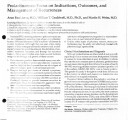|
|
Creator | Title | Description | Subject | Date |
| 226 |
 |
Couldwell, William T. | Pituitary apoplexy: diagnosis and management | Pituitary apoplexy, an uncommon complication of pituitary adenomas, was first decribed in 1898 when pearce Bailey reported hemorrhage into a pituitary adenoma in a 50 year old man with acromegaly. The patient presented with sudden onset of headache, nausea, vomiting, fever, oculomotor palsies, and v... | Pituitary Apoplexy; Pituitary adenoma; Transsphenoidal surgery | 2003 |
| 227 |
 |
Couldwell, William T. | Pituitary gland metastasis from adenocarcinoma of the prostate | A case of prostatic carcinoma metastasis to the pituitary gland is reported. The presentation and rarity of such a lesion is addressed. The literature review yielded only isolated case reports of symptomatic brain metastases unassociated with bone disease from adenocarcinoma of the prostate. The man... | Prostate; Pituitary gland; Adenocarcinoma; Metastasis; Transsphenoidal surgery | 1989 |
| 228 |
 |
Couldwell, William T. | Pituitary models | Pituitary tumor animal models provide researchers a microenvironment that simulates the clinical situation; however, in comparison with astrocytoma and meningioma tumor research where intracranial xenograft transplantations are increasingly being used to test various therapeutic modalities, in vivo ... | | 2013-01-01 |
| 229 |
 |
Couldwell, William T. | Porous polyethylene implant for cranioplasty and skull base reconstruction | Object. Cranial reconstruction after skull base surgery is important for restoration of function and cosmesis. The authors describe their experience with the Medpor porous polyethylene implant for cosmetic cranioplasty and reconstruction after skull base surgery. Methods. Medpor, a biocompatible i... | | 2004 |
| 230 |
 |
Couldwell, William T. | Posterior fossa brain tumors and arterial hypertension | Hypertension caused by arterial compression of the rostral ventrolateral medulla is well described. Much less information is available on the association between neurogenic hypertension and posterior fossa brain tumors. To date, multiple reports have supported the impression that a small subpopulat... | Posterior fossa tumors; Brain stem; Arterial hypertension; Essential hypertension; EHTN | 2006 |
| 231 |
 |
Couldwell, William T. | Posterolateral approach for decompression with anterior and posterior fusion: a less invasive surgical technique for stabilization of the thoracic spine | The goals of surgery in unstable thoracic fractures or tumors involving the thoracic spine are neural decompression, correction of deformity, and stabilization. Several different approaches can be used to achieve these goals. The anterior, combined anterior and posterior, and more recently thoraco... | Decompression; Thoracic spine; Posterolateral approach | 1998 |
| 232 |
 |
Kestle, John R. W. | Potentially useful outcome measures for clinical research in pediatric neurosurgery | The choice of outcome (or outcomes) and their measurement are critical for a sound clinical trial. Surgeons have traditionally measured simple outcomes such as death, duration of survival, or tumor recurrence but have recently developed more sophisticated measures of the effect of an intervention. M... | Pediatric neurosurgery | 2005 |
| 233 |
 |
Couldwell, William T. | Practicing neurosurgery in the United States | Compared with other developed countries, the U.S. spends a high percentage of its gross domestic product on healthcare: 16 percent in 2005, up from 15 percent in 2004. This is far and away the greatest percentage of GDP spent on healthcare of any nation for which such data is collected. However,... | | 2008-01-01 |
| 234 |
 |
Kestle, John R. W. | Predicting shunt failure on the basis of clinical symptoms and signs in children | Object. In evaluating pediatric patients for shunt malfunction, predictive values for symptoms and signs are important in deciding which patients should undergo an imaging study, whereas determining clinical findings that correlate with a low probability of shunt failure could simplify management. ... | Pediatric Shunt Design Trial; PSDT; Shunt failure; Shunt malfunction; Clinical signs | 2001 |
| 235 |
 |
Kestle, John R. W. | Predicting slitlike ventricles in children on the basis of baseline characteristics at the time of shunt insertion | Object. Slit ventricle syndrome (SVS) is a delayed complication of shunt insertion and occurs only in children with slitlike ventricles after shunt placement. Although SVS appears to be related to early shunt placement, its predisposing factors are largely unknown. Methods. Baseline data in 737 chi... | Slitlike ventricles; Slit ventricle syndrome; Shunt insertion; Predictive factor; Ventriculoperitoneal shunt; Pediatric neurosurgery | 2007 |
| 236 |
 |
Couldwell, William T. | Predictive value of serum prolactin levels measured immediately after transsphenoidal surgery | Object. Prolactin-secreting pituitary adenomas may be managed by surgery, medication, radiotherapy, or observation. The authors reviewed a consecutive series of patients who were followed for at least 5 years after surgery to assess the prognostic significance of preoperative factors (tumor size and... | Prolactin; Transsphenoidal surgery; Pituitary adenoma; Prolactinoma; Transsphenoidal approach | 2002 |
| 237 |
 |
Kestle, John R. W. | Priorities for hydrocephalus research: report from a National Institutes of Health-sponsored workshop | Object. Treatment for hydrocephalus has not advanced appreciably since the advent of cerebrospinal fluid (CSF) shunts more than 50 years ago. Many questions remain that clinical and basic research could address, which in turn could improve therapeutic options. To clarify the main issues facing hydr... | Biomedical research | 2007 |
| 238 |
 |
Couldwell, William T. | Prognostic variables in surgery for skull base meningiomas | The authors have retrospectively analyzed selected surgical and pathological observations made among a group of 20 patients harboring recurrent cranial base meningiomas in an attempt to reveal which factors may be important in predicting tumor recurrence. This cohort was compared with a group of 3... | Skull base; Prognostic factor; Recurrence | 1997 |
| 239 |
 |
Couldwell, William T. | Prolactinomas: focus on indications, outcomes and management of recurrences | Although prolactinomas are discovered at autopsy with equal frequency in women and men, they present clinically in women far more often than in men. In children, "in whom they are the most common type of adenoma, prolactinomas are seen more often in girls than in boys. In a series of nearly 400 PRL... | Outcome; Pituitary adenoma; Prognosis; Prolactin; Transsphenoidal surgery | 1999 |
| 240 |
 |
Kestle, John R. W. | Propionibacterium encephalitis [Letter to the editor] | To THE EDITOR: We read with interest the article by Camarata, et al., reporting two cases of dorsal midbrain encephalitis (Camarata PJ, McGeachie RE, Haines S J: Dorsal midbrain encephalitis caused by Propionibacterium aches. Report of two cases. J Neurosurg 72." 654-659, April, 1990). There are... | | 1990 |
| 241 |
 |
Couldwell, William T. | Protein kinase C activity correlates with the growth rate of malignant gliomas: Part II. Effects of glioma mitogens and modulators of protein kinase C | THE PROLIFERATION RATES of gliomas may be modulated by the protein kinase C (PKC) signal transduction system. The present study was undertaken to further examine the role of PKC system in growth regulation of gliomas in vitro by measurement of PKC activity over various phases of tumor growth and by ... | Protein kinase C; Brain neoplasms; Growth factor; Glioma; Phorbol ester | 1992 |
| 242 |
 |
Couldwell, William T. | Protein kinase C and growth regulation in malignant gliomas | To the Editor: The presence of amplified growth factor systems in many tumor models, including malignant gliomas, raises the question of how such external signals are transduced into a transformed phenotype (increased proliferation, invasion, lack of contact inhibition, angiogenic capacity, etc.). ... | Protein kinase C; Glioma; Brain neoplasm; protooncogenes; Apoptosis; Tamoxifen | 1994 |
| 243 |
 |
Couldwell, William T. | Protein kinase C inhibitors suppress cell growth in established and low-passage glioma cell lines. a comparison between staurosporine and tamoxifen | WE HAVE PREVIOUSLY demonstrated that the proliferation of established human glioma cell lines correlated with protein kinase C (PKC) activity and that a relatively selective PKC inhibitor, staurosporine, inhibits glioma cell proliferation. The purpose of this study was to determine whether low-passa... | Staurosporin; Tamoxifen; Protein kinase C; Glioma; Brain neoplasm; Glioma cell lines | 1993 |
| 244 |
 |
Couldwell, William T. | Radiographic features of tumefactive giant cavernous angiomas | Giant cavernous angiomas (GCAs) are very rare, and imaging features of GCAs can be very different from those of typical cavernous angiomas (CAs), making them a diagnostic challenge. The purpose of the study was to evaluate the radiographic features of GCAs, with an emphasis on the differentiating fe... | Cavernous angiomas; Cavernous malformations; Tumefactive | 2008 |
| 245 |
 |
Kestle, John R. W. | Randomized trial of cerebrospinal fluid shunt valve design in pediatric hydrocephalus | OBJECTIVE: Forty percent of standard cerebrospinal fluid shunts implanted for the treatment of pediatric hydrocephalus fail within the first year. Two new shunt valves designed to limit excess flow, particularly in upright positions, were studied to compare treatment failure rates with those for st... | Shunt failure; Valve design; Orbis-Sigma valve; Delta valve | 1998 |
| 246 |
 |
Couldwell, William T. | Rathke cleft cyst intracystic nodule: a characteristic magnetic resonance imaging finding | Object. The fluid content of Rathke cleft cysts (RCCs) displays variable appearances on magnetic resonance (MR) images and can appear indistinguishable from other intrasellar or suprasellar cystic lesions. Intracystic nodules associated with individual RCCs have been noted, but to date their signifi... | | 2005 |
| 247 |
 |
Osborne, Anne G.; Couldwell, William T. | Rathke cleft cyst intracystic nodule: a characteristic magnetic resonance imaging finding. | OBJECT: The fluid content of Rathke cleft cysts (RCCs) displays variable appearances on magnetic resonance (MR) images and can appear indistinguishable from other intrasellar or suprasellar cystic lesions. Intracystic nodules associated with individual RCCs have been noted, but to date their signifi... | Brain Neoplasms; Central Nervous System Cysts; Magnetic Resonance Imaging | 2005-11-01 |
| 248 |
 |
Couldwell, William T. | Recurrent infrasellar clival craniopharyngioma | The patient is a 44-year-old man who underwent resection of a posterior nasopharynx tumor 12 years earlier via left lateral rhinotomy approach. The final pathological analysis indicated the tumor was a craniopharyngioma, and the patient subsequently underwent focal radiation. The patient returned t... | Ectopic Craniopharyngioma; Recurrence; Infrasellar; Clivus | 2007 |
| 249 |
 |
Kestle, John R. W. | Reduction of hemorrhage risk after stereotactic radiosurgery for cavernous malformations | The benefits of radiosurgery for cavernous malformations are difficult to assess because of the unclear natural history of this vascular lesion, the inability to image malformation vessels, and the lack of an imaging technique that defines "cure." The authors selected for radiosurgery 47 patients w... | Cavernous malformation; Gamma knife; Stereotactic radiosurgery | 1995 |
| 250 |
 |
Kestle, John R. W. | Reduction of transfusion rates in the surgical correction of sagittal synostosis | Object. As public concern about the risks of blood transfusions increased in the mid-1990s, avoidance of transfusions became a goal of surgery for sagittal synostosis. This study was performed to confirm a hypothesized reduction in transfusion rates in recent years and to identify factors associated... | Sagittal synostosis; Sagittal craniosynostosis; Craniectomy; Allogenic blood transfusion; Reduction | 2002 |

























